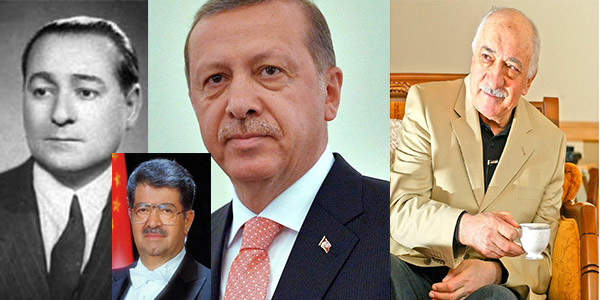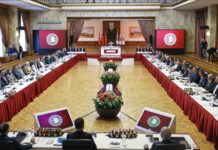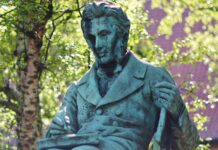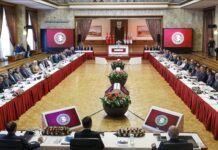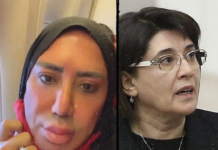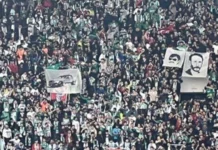In the previous article, I described the contents of Ceylan Yeğinsu’s most recent NYT feature (1), on the current violence in Turkey’s Southeast. Then I explained that her article’s approach only becomes believable when the reader is unaware of certain essential pieces of information. That information concerns not only the current circumstances, but the historical background to Turkey’s political situation (2).
Turkish state institutions, until recently, functioned far more as political tools rather than for the public good. This precedent was established in the early Turkish Republic when Mustafa Kemal’s political party, the Republican People’s Party (CHP), established a system in which the single party controlling parliament was also the single party in control of all state institutions. The party was the state, and the state was the party.
One implication of this original power configuration was that, when new political forces, especially those from outside the Turkish “historical bloc” (3), came to control parliament (as the Democrat Party did in 1950 after the Turkish political system became pluralistic in the late 1940s), that new actor was faced with a situation in which Turkish state institutions were entirely controlled by forces politically hostile to it. In order to carry out political decisions that carried a popular democratic mandate, the new political actor needed to struggle through the political resistance, which was democratically unaccountable and embedded in the state. That struggle ended up costing Adnan Menderes his life; Turgut Özal took a different route, to skirt state institutions where possible, that ended up exacerbating the informal economic sectors, inflation, and lawlessness. Still, under Özal and his successors in the 1980s and 1990s, the Turkish economy grew and all aspects of Turkish society became much more complex, while Turkish state institutions stagnated and became less and less capable of providing services to a quickly modernizing nation.
In sum, Turkish state institutions have always been a political battleground with various forces, the most powerful being the Turkish military, constantly working for commanding influence. These forces were always concerned with exerting their own political influence and interests through state institutions. Serving the public was not the goal. The results were massive corruption, no transparency, inefficiency and, in the security forces, rampant human rights violations. This situation remained largely the same until the AKP era.
The most recent entrants into the struggle for control over Turkish state institutions were the followers of Fethullah Gülen. Since the 1980s they have been, slowly and steadily, establishing their own network of officials in, especially, the police and the judiciary (although they clearly are powerful in other institutions, too). The infamous Ergenekon and Balyoz investigations into military preparations for a new coup d’état were, as we later learned, put together by Fethullah Gülen’s supporters in the police and judiciary. Leaving aside the many questions about those investigations’ legitimacy, the ultimate effect was to greatly reduce the Turkish military’s ability to control political decision-making. Correspondingly, this meant that the Turkish military’s strength in Turkish state institutions declined, and the strength of Fethullah Gülen’s supporters increased.
The advent of Gülenist influence in the Turkish police and judiciary did have positive effects. In the past decade, human rights violations, especially torture, have greatly decreased. But the overall professional quality of the police forces and judiciary did not seem to improve, apparently because the Gülenists ultimately had the same aim — to exert their own power and protect their interests in state institutions — that the previous actors had. This is why the AKP eventually had to act to reduce Gülenist influence, too, in state institutions.
That effort to deconstruct Gülenist influence in Turkish state institutions has been playing out over the past four years, and accounts for most of the political upheavals (apart from the Kurdish question) that Turkey has experienced in that time span. At the same time, the rooting out of Gülenist figures from the police and military hierarchies seems to have resulted in more efficient performance. At the street-level, Istanbul police are becoming more professional, both in job performance and appearance. The Turkish military, for its part, now seems to be much more effective in carrying out operations against the PKK. And Turkish intelligence operations now seem to be more efficient and active. Naturally, only time will tell whether these trends will continue.
Now, I realize that a journalist, such as Ceylan Yeğinsu, cannot repeat all of this information in every feature. However, this information should inform and temper what a journalist puts into writing. That is where the issues of context and interpretation arrive: because of the struggle to reduce the influence of non-political, non-accountable, and anti-democratic forces in Turkish state institutions, the AKP and President Erdoğan have taken steps that appear regressive to some observers. The political context, however, should result in far more circumspect reporting about current Turkish politics than what we have witnessed in the past four years.
For example, reports from various sources claim that the Turkish state is killing civilians in the current violence. Ceylan Yeğinsu’s article mentions some of the civilian casualties and avoids placing direct blame herself. Instead, she quotes an activist plus Aslı Aydıntaşbaş, who do the accusing for her. The result is that, despite the fact that the PKK is clearly to blame for the ongoing clashes, the reader of Yeğinsu’s article is meant to understand that the Turkish state is still oppressing, even murdering, Turkey’s Kurds.
Ultimately, the decisions on Turkish politics lie with the Turkish voters, who are incomparably better informed about these issues than even many of the policy wonks writing on Turkish issues for Washington, D.C. think tanks. Recent polls suggest that popular support for the HDP has withered, and some prominent Turkish political commentators, who threw in their cause with the HDP for the past year in a short-term, last-ditch effort to defeat the AKP, have begun to hop off of the bandwagon. Little by little, the realization that the PKK’s leadership in the Qandil Mountains never intended to make peace, and that the current violence was the PKK’s choice, is seeping into even the most anti-AKP circles. Eventually even the NYT will have to accept this assessment.
NOTES
(1) http://www.nytimes.com/2015/12/31/world/europe/turkey-kurds-pkk.html?ref=europe&_r=0
(2) The most comprehensive English-language analyses of the background to the current violence in Turkey’s Southeast are available on Serbestiyet’s website. See, especially: Halil Berktay, “From a domestic opposition leader, to a dream of becoming prime minister for Bakur-Rojava (1)” (3rd January 2016) and “On the way to Bakur-Rojava (2) How did the PKK decide to go back to war?” (6th January 2016). For further English-language Serbestiyet articles on this issue, see also: Melih Altınok, “PKK, HDP drag Kurds into bloody adventure” (4th January 2016); Cengiz Alğan, “If Not Now, When?” (31st December 2015); Kurtuluş Tayiz, “Preparing for 'civil war' during the solution process” (29th December 2015); Vahap Coşkun, “The virtual defenders of the ditches” (28th December 2015) and “The purpose of the ditches” (27th December 2015).
(3) The Turkish “historical bloc” is defined and explained in Hasan Bülent Kahraman’s Türk Siyasetinin Yapısal Analizi (A Structural Analysis of Turkish Politics) series of studies.


